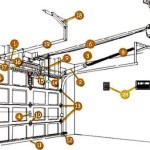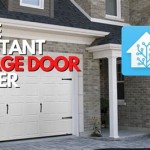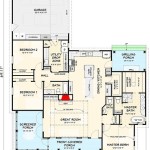How to Open a Broken Garage Door: A Comprehensive Guide
A broken garage door can present a significant inconvenience, disrupting daily routines and potentially compromising security. Understanding the common causes of garage door malfunctions and the steps involved in safely opening a malfunctioning door is essential for homeowners. This article provides a comprehensive guide to navigating this situation, focusing on safety precautions and practical troubleshooting techniques.
The initial assessment of the broken garage door is crucial. Before attempting any repair or manual operation, carefully examine the door, its components, and the surrounding area. Look for obvious signs of damage, such as broken springs, frayed cables, or obstructions on the tracks. Note the position of the door – is it fully closed, partially open, or stuck in an unusual position? Disconnecting the garage door opener is vital for safety. Locate the emergency release cord, typically a red handle hanging from the opener's rail. Pull this cord firmly downwards to disengage the opener from the door. This allows for manual operation.
Identifying the Problem: Common Garage Door Issues
Several factors can contribute to a broken garage door. Pinpointing the underlying issue is the first step toward safely opening the door and eventually implementing repairs. Common problems include:
Broken Springs: Garage door springs are under immense tension and are responsible for counterbalancing the weight of the door. If a spring breaks, the door will feel very heavy and difficult to lift. A loud bang is often heard when a spring fails. Attempting to lift a door with a broken spring can be dangerous; the door could come crashing down.
Cable Problems: Cables connect the springs to the bottom brackets of the door. If a cable is frayed, snapped, or has slipped off the drum, the door will likely be unbalanced and difficult to move. Inspect the cables carefully for any signs of damage or misalignment.
Track Issues: The garage door rollers run along vertical and horizontal tracks. If the tracks are bent, dented, or obstructed, the door will not move smoothly. Check for debris, loose fasteners, and any visible damage to the tracks. Rollers that are off the track will prevent the door from operating.
Opener Malfunctions: While the focus here is on manual operation, a malfunctioning garage door opener can leave the door inoperable. Electrical problems, sensor issues, or a faulty motor can all prevent the opener from functioning correctly. Even if the opener appears to be working, it might not be properly connected to the door after disengaging the emergency release.
Obstructions: Sometimes, the simplest explanation is the correct one. Check for any obstructions blocking the door's path, such as tools, debris, or snow accumulation. Even a small obstruction can prevent the door from opening or closing properly.
Roller Problems: The rollers are essential for the door's smooth movement along the tracks. Inspect the rollers for wear, damage, or any signs of them being off-track. Damaged or improperly seated rollers can cause significant friction and hinder the door's operation.
Safety Precautions: Prioritizing Well-being
Working with a potentially malfunctioning garage door requires strict adherence to safety protocols. The heavy weight of the door and the high tension in the springs pose significant risks. Before attempting any manual operation, observe the following precautions:
Wear Protective Gear: Always wear safety glasses to protect your eyes from dust, debris, or flying fragments. Gloves will provide a better grip and protect your hands from sharp edges or splinters. Closed-toe shoes are also essential to prevent foot injuries.
Never Work Alone: Having a second person present is highly recommended. They can provide assistance, offer a second opinion, and call for help in case of an emergency. A second person can also help stabilize the door as you work on it.
Avoid Working Under a Partially Open Door: A partially open door is unstable and could collapse without warning. If the door is stuck in a partially open position, use clamps or locking pliers on the track below the bottom rollers to prevent it from falling. However, this is a temporary measure and should only be used to stabilize the door while you assess the situation.
Never Attempt to Repair Springs: Garage door springs are under extreme tension and can cause serious injury or death if mishandled. Spring repair should only be performed by qualified professionals. If you suspect a broken spring, do not attempt to fix it yourself; call a garage door repair service immediately.
Be Aware of Pinch Points: Garage doors have numerous pinch points where fingers or hands could get caught. Be especially careful when working around rollers, hinges, and other moving parts.
Properly Secure the Door: If you manage to open the door manually, ensure it is properly secured in the open position. Use clamps or locking pliers on the track to prevent it from accidentally closing. This is particularly important if you need to leave the door open unattended.
Steps to Manually Open the Garage Door
Assuming the initial assessment is complete, safety precautions are in place, and the garage door opener is disengaged, the following steps can be taken to manually open the door:
Assess the Weight: After disengaging the opener, try to lift the door slightly to gauge its weight. If it feels exceedingly heavy or is difficult to move even a few inches, it likely indicates a broken spring. Do not attempt to force the door open under these circumstances; call a professional.
Inspect the Tracks and Rollers: Examine the tracks for any obstructions or damage. Remove any debris or loose objects that might be hindering the rollers. If a roller is off the track, try to gently guide it back into place. Use a lubricant, such as WD-40 or silicone spray, to help the rollers move more smoothly along the tracks.
Lift the Door Gradually: If the door feels manageable, attempt to lift it gradually in small increments. Apply even pressure to both sides of the door to prevent it from binding or becoming unbalanced. Have your assistant help lift the door if needed. Use a step ladder for support if the door is high and you cannot reach it easily.
Address Resistance: If you encounter resistance while lifting the door, stop and re-evaluate the situation. Do not force the door open, as this could cause further damage or injury. Check for any binding points or obstructions that you may have missed. Apply lubricant to the tracks and rollers to reduce friction. Try rocking the door gently back and forth to see if you can free it from whatever is causing the resistance.
Secure the Open Door: Once you have successfully opened the door, secure it in the open position to prevent it from falling. Use clamps or locking pliers on the track below the bottom rollers. Ensure the clamps are securely fastened and cannot be easily dislodged. If you plan to leave the door open for an extended period, consider using additional supports, such as wooden blocks or metal braces, for added security.
When To Call a Professional: There are situations where attempting to open a broken garage door yourself is not advisable. These include:
Broken Springs: As previously emphasized, spring replacement is a dangerous task that should only be performed by trained technicians.
Extensive Damage: If the garage door has sustained significant damage, such as a severely bent track or a broken panel, attempting to open it manually could be hazardous.
Unfamiliarity: If you are not comfortable working with mechanical devices or are unsure about the steps involved, it is best to err on the side of caution and call a professional.
Inability to Diagnose the Problem: If you are unable to identify the cause of the malfunction, a qualified technician can diagnose the problem accurately and recommend the appropriate solution.
The door is exceptionally heavy. This is usually indicative of component failure that you are not qualified to repair.
Opening a broken garage door requires patience, caution, and a methodical approach. By understanding the common causes of garage door malfunctions, observing strict safety precautions, and following the steps outlined in this guide, homeowners can safely navigate this challenging situation. Remember that your safety is paramount. When in doubt, always consult a qualified garage door repair professional.

How To Open A Broken Garage Door Spring

Can I Open My Garage Door If The Spring Is Broken Doorvana Doors

How To Open A Garage Door With Broken Torsion Spring

Garage Door Spring Broke No Problem With These Easy Steps

How To Open A Garage Door Manually When Opener Is Broken

Can You Open A Broken Garage Door Doctor

Fix Garage Door Repair
How To Open Garage Door With Broken Spring Step By

How To Open Garage Door If Spring Is Broken Expert Guide

How To Open Garage Door With Broken Spring 979 218 9213








